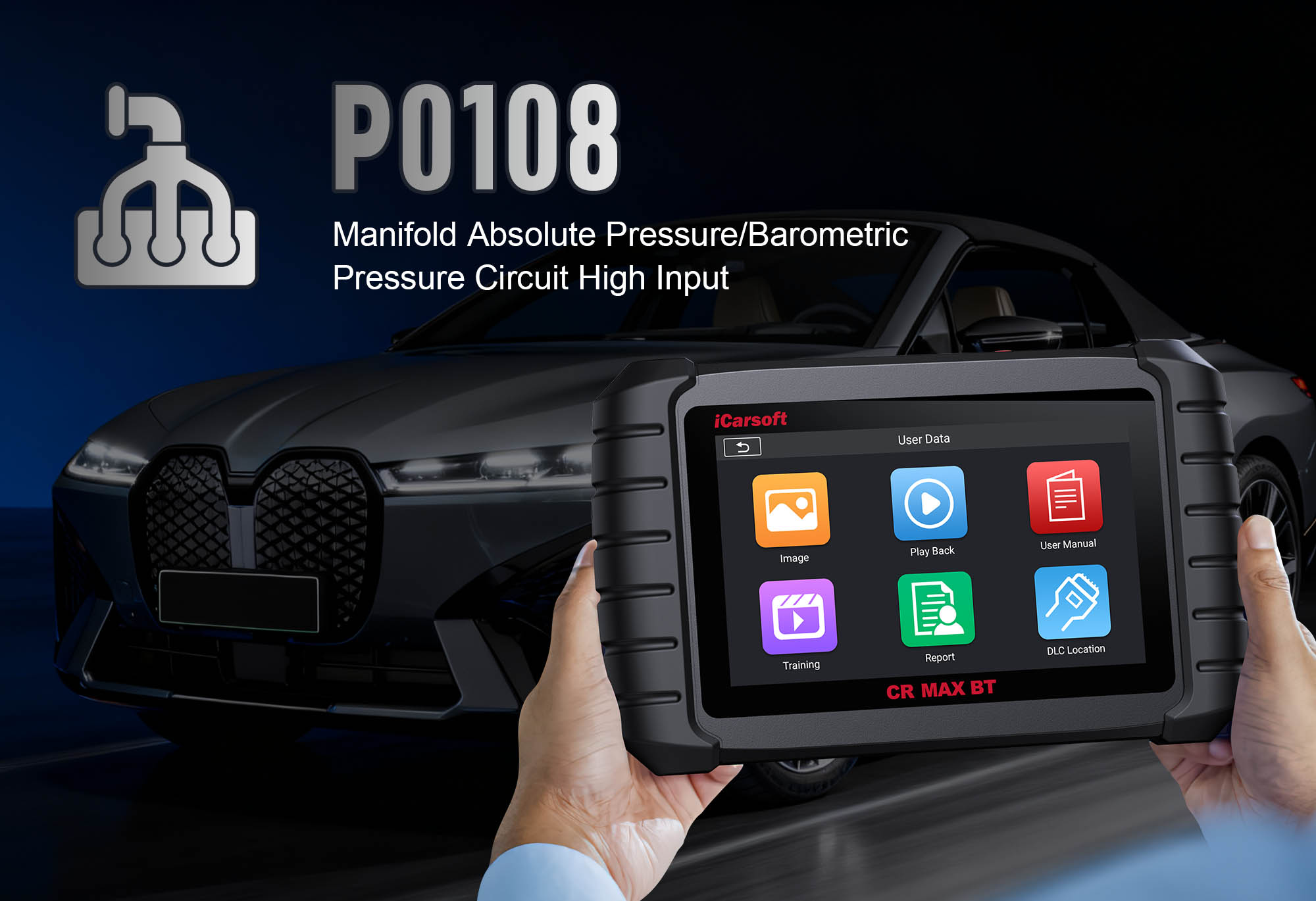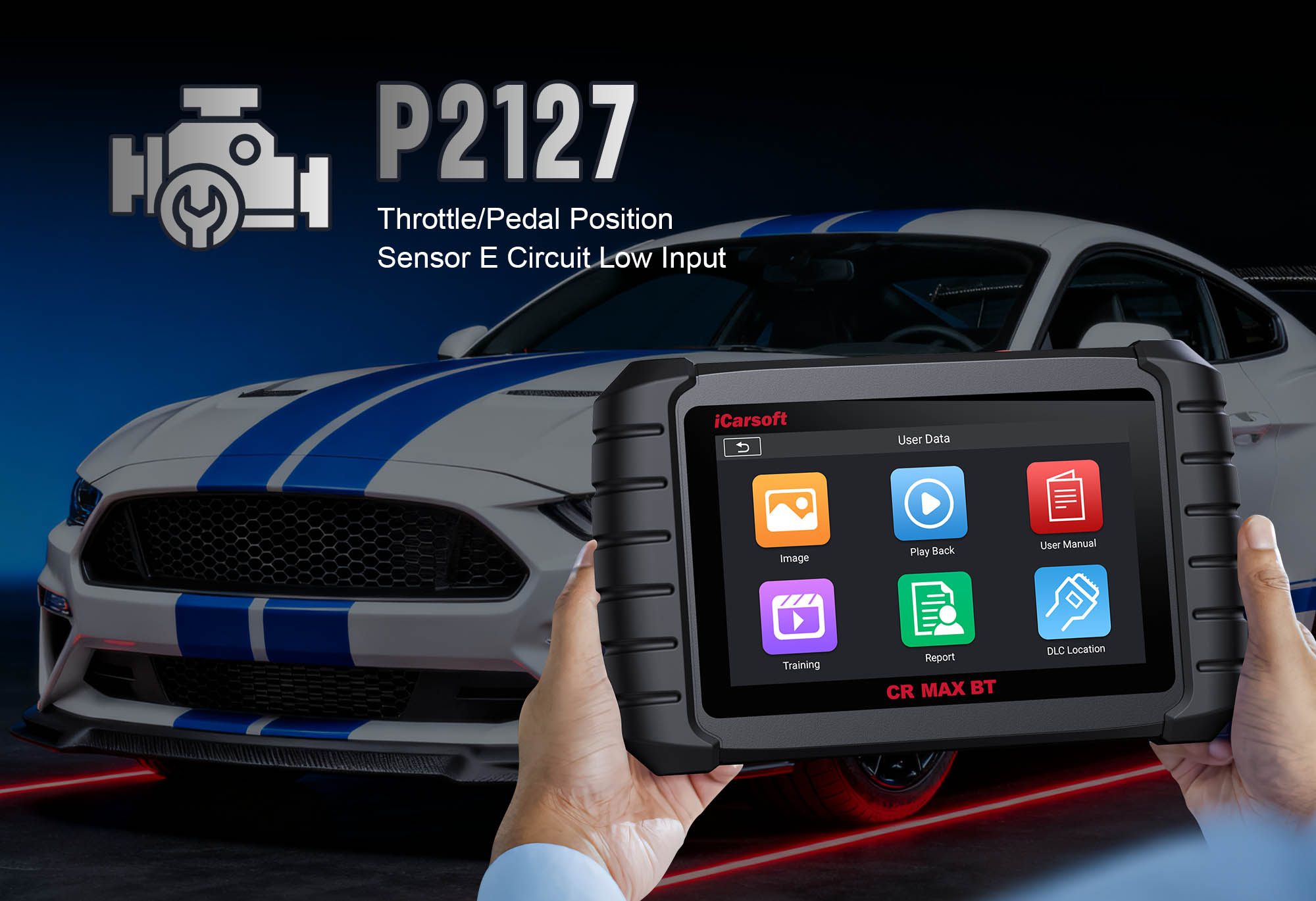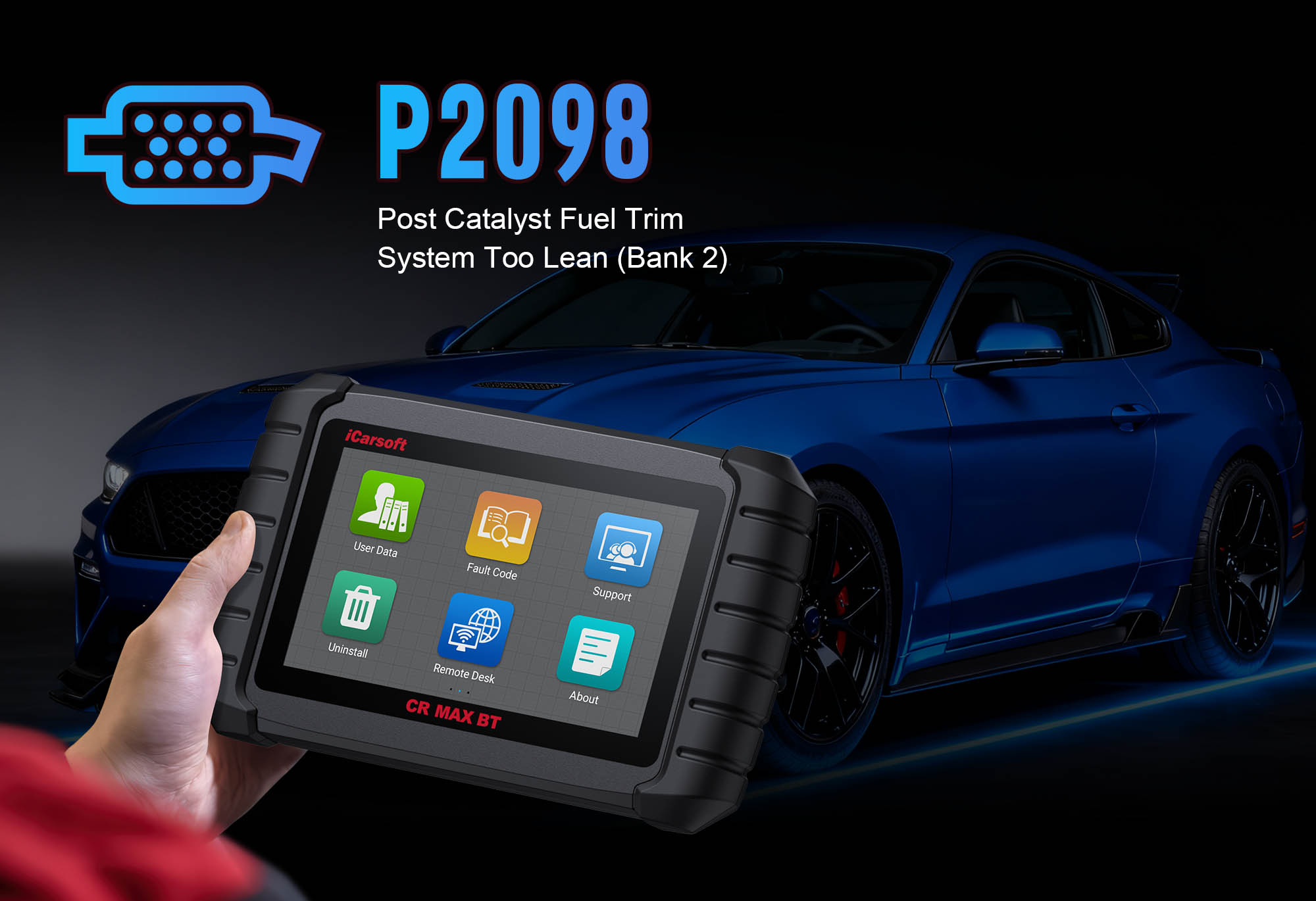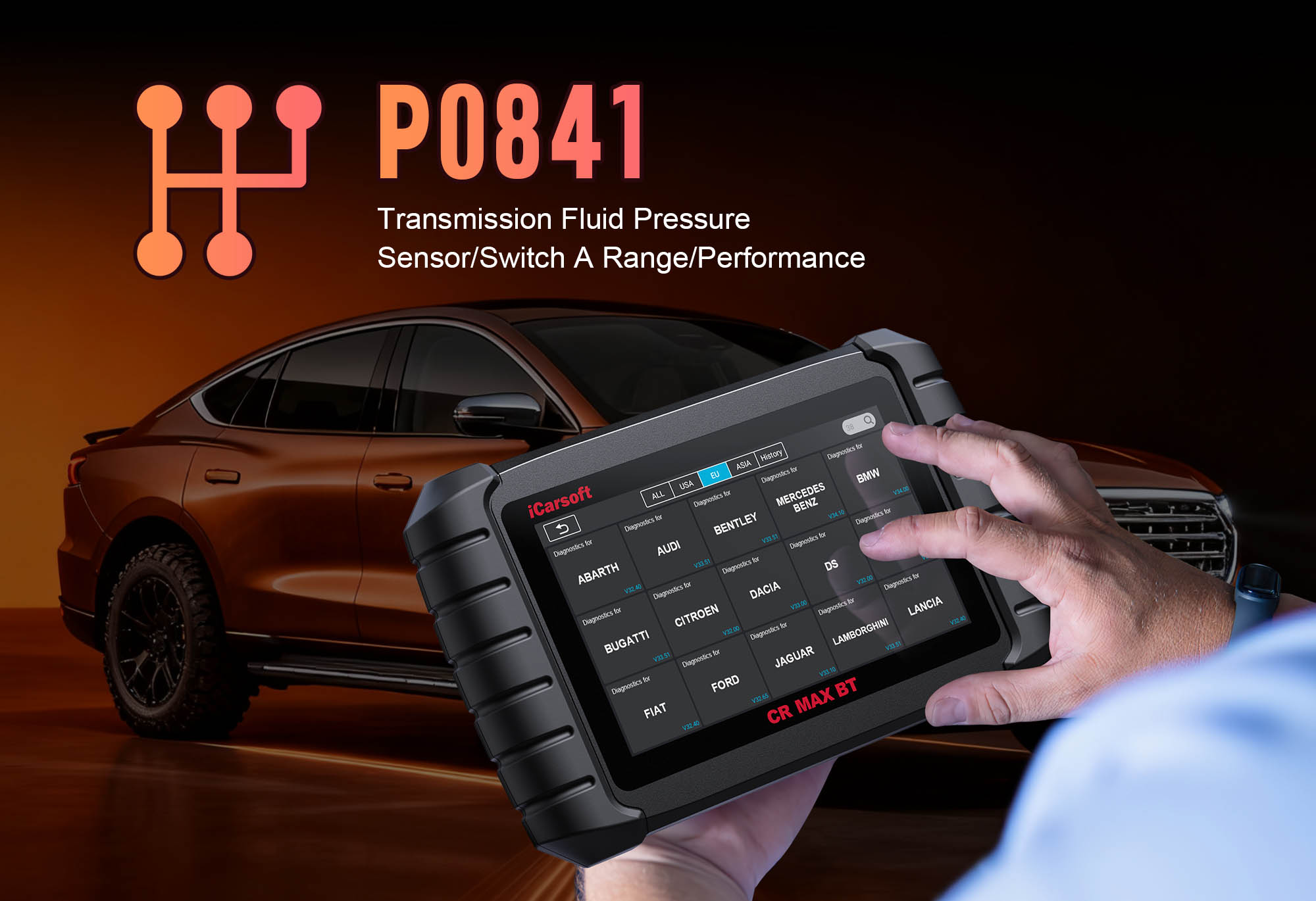Diagnose & Clear P0108 with iCarsoft CR MAX BT: Fix Manifold Absolute Pressure Sensor Circuit High Voltage
Diagnose & Clear P0108 with iCarsoft CR MAX BT
If your vehicle’s check engine light flickers on, you experience rough idling, or it struggles with poor acceleration, a diagnostic scan will likely return P0108. This OBD-II code stands for "Manifold Absolute Pressure (MAP) Sensor Circuit High Voltage"—a critical fault affecting the MAP sensor. The MAP sensor measures intake manifold pressure to help the Engine Control Module (ECM) calculate air-fuel ratios and ignition timing.
When the sensor sends abnormally high voltage signals (typically above 4.5V), the ECM misinterprets engine load, leading to inefficient combustion, reduced power, and increased emissions. Basic scanners can’t isolate faults, but the iCarsoft CR MAX BT with specialized MAP sensor diagnostics solves this. Let’s break down how to resolve P0108 step by step.
Understanding P0108: Symptoms & Causes
The MAP sensor (often mounted on the intake manifold or firewall) converts manifold pressure into electrical signals: at idle (low pressure), it sends ~0.9V; at wide-open throttle (high pressure), it sends ~4.5V. P0108 triggers when the ECM detects voltage above the manufacturer’s threshold (usually >4.5V), indicating an open circuit, sensor failure, or incorrect signal.
Key Symptoms of P0108
-
Illuminated Check Engine Light (CEL): A steady CEL illuminates, and some vehicles display a "Fuel System Error" or "Engine Performance Warning."
-
Rough Idling & Stalling: The ECM overfuels due to misread pressure, causing unstable idle or stalling at stops.
-
Poor Acceleration: Incorrect air-fuel ratios limit power, making it hard to merge or pass at highway speeds.
-
Increased Fuel Consumption: Overfueling drops mileage by 15–20%, wasting fuel and increasing emissions.
-
Cold-Start Issues: The sensor fails to adjust for low-pressure cold starts, leading to hesitation or difficulty starting.
Common Causes of P0108
|
Cause
|
Description
|
|
Faulty MAP Sensor
|
Internal component failure (e.g., damaged pressure diaphragm) causes high-voltage signals, even at low pressure.
|
|
Damaged Sensor Wiring
|
Frayed wires, rodent chew marks, or corrosion in power/ground lines create an open circuit, spiking voltage.
|
|
Loose/Corroded Connector
|
The sensor’s 3–4 pin connector (near intake manifold) becomes loose or rusted, disrupting signal flow.
|
|
Vacuum Leaks
|
A leak in the vacuum hose (connecting MAP sensor to intake manifold) causes incorrect pressure readings, triggering voltage spikes.
|
|
Blown MAP Sensor Fuse
|
A dedicated "MAP Sensor" or "Sensor Power" fuse in the under-hood box blows, cutting power and causing voltage irregularities.
|
|
ECM Malfunction
|
Rarely, the ECM’s internal MAP signal processing circuit fails, misinterpreting voltage levels.
|
Why iCarsoft CR MAX BT Excels at Diagnosing P0108
The CR MAX BT outperforms basic tools with features tailored to MAP sensor diagnostics. Here’s its key value:
Wireless Bluetooth Connectivity
Test the MAP sensor (tight engine bay spaces) from up to 30 feet away—no tangled cords hinder access.
Live Voltage & Pressure Tracking
Monitors real-time voltage (0.9V–4.5V normal) and pressure (1–29 psi), instantly flagging high-voltage spikes (>4.5V).
Sensor Response Tests
Sends simulated pressure signals to verify voltage adjustment (rising pressure = rising voltage, within limits).
Vacuum Leak Detection
Compares MAP readings to throttle position sensor (TPS) data, highlighting leaks (inconsistent pressure at steady throttle).
AutoVIN Identify
Automatically detects vehicle make/model and MAP specs (voltage range, pinouts) in seconds—no manual lookup.
Step-by-Step: Diagnose & Clear P0108 with iCarsoft CR MAX BT
-
Initial Visual Inspection (Save Time First)
1. Locate the MAP sensor: Use CR MAX BT’s Component Location > Engine > Intake System > MAP Sensor (near throttle body/firewall, connected to intake via vacuum hose).
2. Inspect vacuum hose: Check for cracks, disconnections, or kinks—replace if faulty (causes pressure leaks).
3. Check connector: Disconnect (gloves if engine warm), inspect corrosion/bent pins—clean with contact cleaner, apply dielectric grease.
4. Inspect wiring: Follow harness to ECM, check frays/heat damage—repair with heat-shrink; replace if severe.
5. Check MAP fuse: Use Fuse Guide to locate/test—replace if blown (same amperage: 5A/10A).
-
Connect the Tool & Confirm P0108
Plug CR MAX BT into OBD-II port, power on, select AutoVIN Identify to retrieve specs. Navigate to Engine > Fault Codes > Read Codes to confirm P0108. Tap Code Details for vehicle-specific insights (e.g., "Ford Mustang: MAP High Voltage; Expected 0.9–4.5V, Actual 5.0V"), and check related codes (e.g., P0107, P0113).
-
Monitor Live MAP Sensor Data
Start engine, idle 5 minutes (stabilizes sensor). Navigate to Engine > Live Data > MAP Sensor:
- Voltage: Normal = ~0.9V (idle) → ~4.5V (wide-open throttle); >4.5V confirms P0108.
- Pressure: Compare to atmospheric (~14.7 psi at sea level); idle = ~10–12 psi; stuck 0/max psi = fault.
- Throttle test: Rev gradually—voltage/pressure should rise smoothly; erratic spikes/flat line = faulty sensor/leak.
-
Test MAP Sensor Circuit Integrity
Turn off engine, disconnect MAP sensor connector:
1. Power wire test: Set multimeter to "DC Voltage"—touch power pin ("V+" in pinout) + ground. Ignition "ON" = 5V (standard); 0V = blown fuse/broken wire.
2. Ground wire test: Set to "Ohms"—touch ground pin ("GND") + chassis ground. Normal = <1 ohm; >5 ohms = poor ground.
3. Signal wire test: Check continuity between signal pin and ECM (use wiring diagram)—no continuity = broken wire.
-
Test the MAP Sensor & Vacuum System
1. MAP sensor bench test: Remove sensor (torque 8–10 ft-lbs per Component Removal Guide):
- Connect sensor to its connector (or jumper wires for power/ground).
- Apply gentle vacuum (hand pump) to inlet port—monitor voltage with CR MAX BT’s multimeter. Good sensor: 0.9V (0 psi) → 4.5V (20 psi); stays >4.5V/no change = faulty.
2. Vacuum leak test: Reconnect sensor, start engine. Navigate to Engine > Live Data > MAP Sensor + TPS. Hold throttle at 2000 RPM—stable pressure = good; fluctuations = leak (check hoses/intake gaskets).
-
Repair & Clear P0108
- Vacuum leaks/faulty fuse: Replace cracked hoses or OEM-compatible fuses.
- Wiring/connector: Repair frays; clean connectors with dielectric grease.
- Faulty MAP sensor: Replace with OEM-equivalent (use Part Lookup—e.g., Bosch 0281002452 for GM, Denso 197400-2170 for Toyota); torque to specs, reconnect vacuum hose.
- ECM malfunction: Consult dealer for reprogramming/replacement (last resort—confirm with ECM communication test).
Clear code: Go to Engine > Fault Codes > Clear Codes to delete P0108.
-
Validate the Repair
1. Monitor data: Start engine—confirm voltage ranges 0.9V (idle)→4.5V (wide-open throttle) with smooth transitions.
2. Test drive: Operate 20–30 minutes (idle/acceleration/highway)—verify no rough idling/stalling/hesitation.
3. I/M Readiness Test: Run via OBDII Functions for emissions compliance.
4. Save report: Use History & Report to document diagnostic data for future reference.
Preventing P0108 Recurrence
-
Regular Sensor Checks: Use Service Reminder to test the MAP sensor every 30,000 miles—catch early wear before P0108 triggers.
-
Vacuum System Inspections: Check hoses/gaskets every 15,000 miles (use live data to verify pressure stability).
-
Wiring Protection: Shield the sensor’s harness with heat-resistant loom—inspect for damage during oil changes.
-
Lifetime Free Updates: Use One-Key Upgrade (Wi-Fi) to add new MAP diagnostic features.
Conclusion
P0108’s high-voltage MAP sensor fault disrupts engine performance and fuel efficiency, but the iCarsoft CR MAX BT simplifies diagnosis with wireless convenience, live tracking, and vacuum leak detection. Whether you’re a DIYer or pro, this tool ensures you fix the root cause—avoiding trial-and-error and poor engine performance.
With global vehicle coverage and 40+ service functions, the CR MAX BT is a long-term investment. Restore accurate air-fuel ratio control, regain power, and drive with confidence—all with one professional-grade diagnostic tool.





